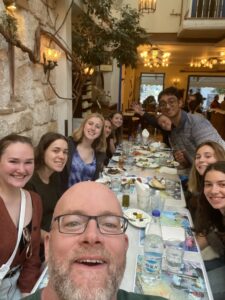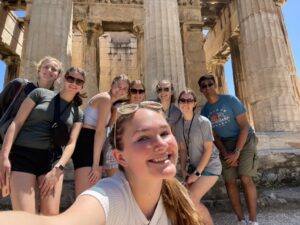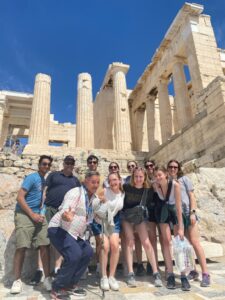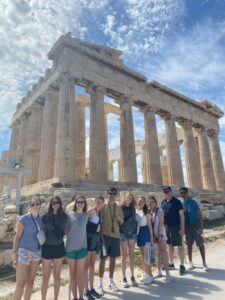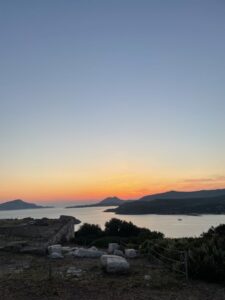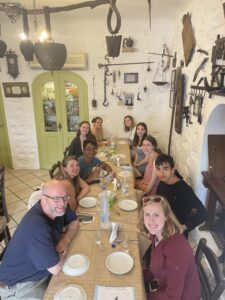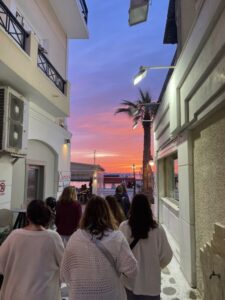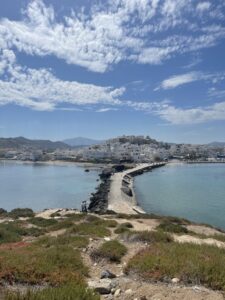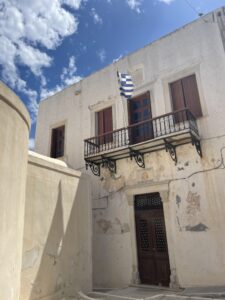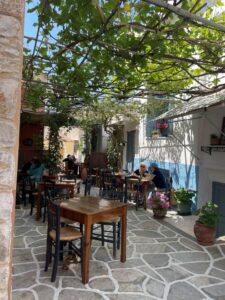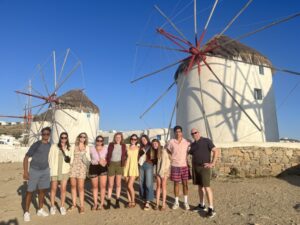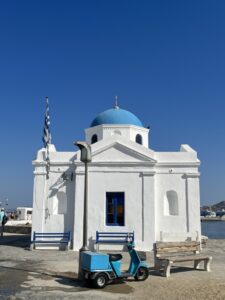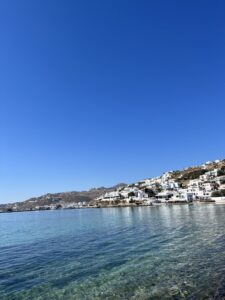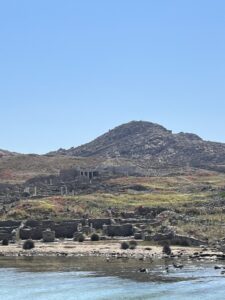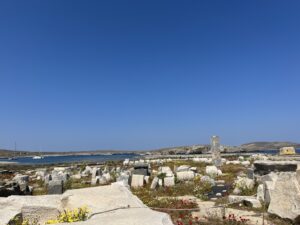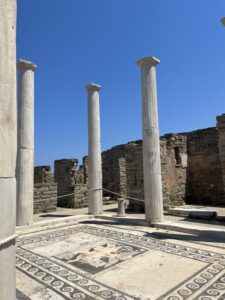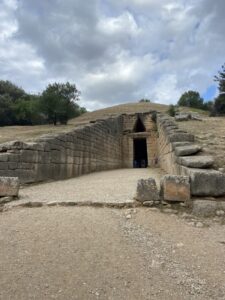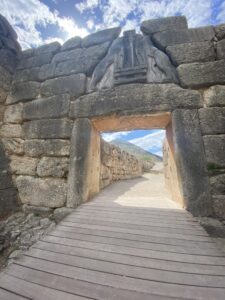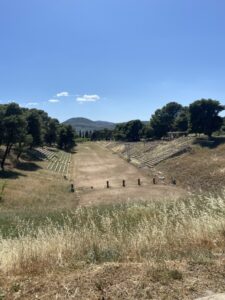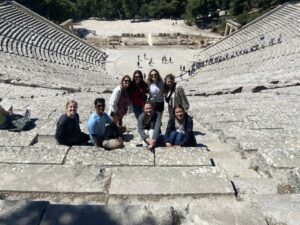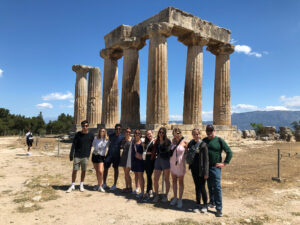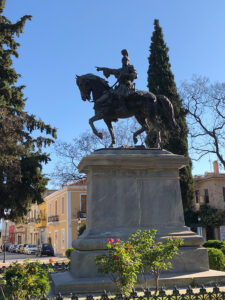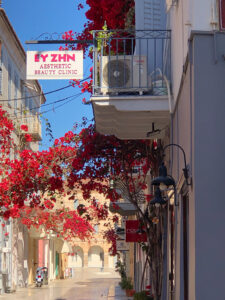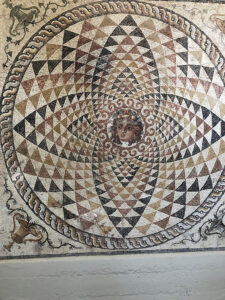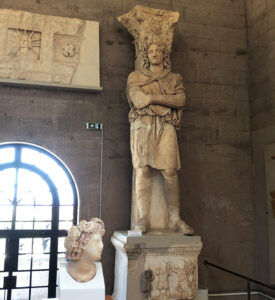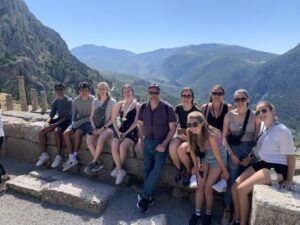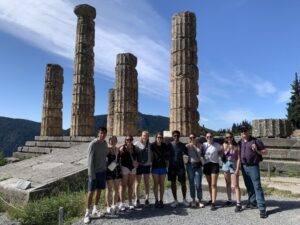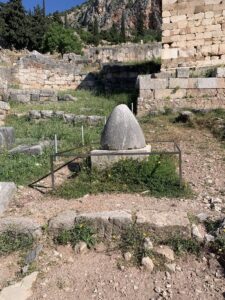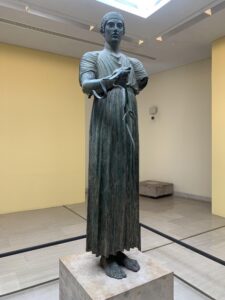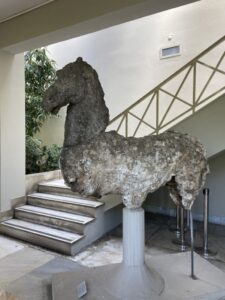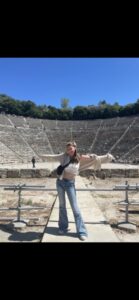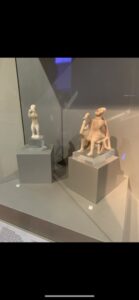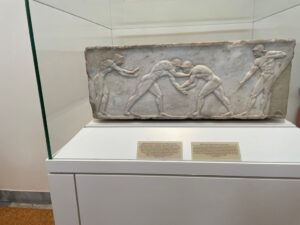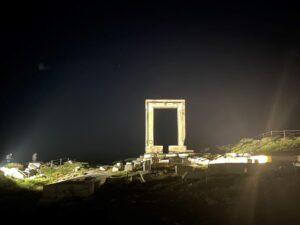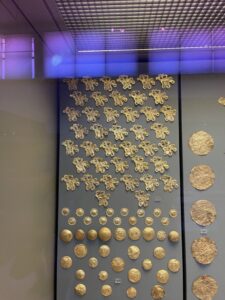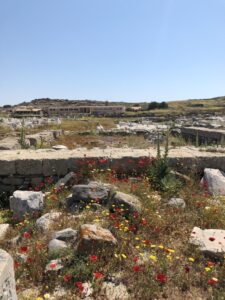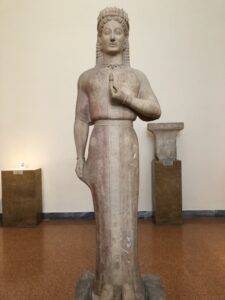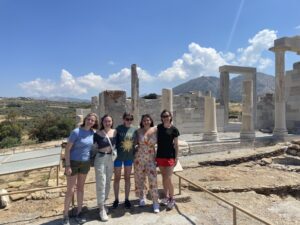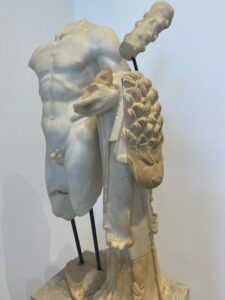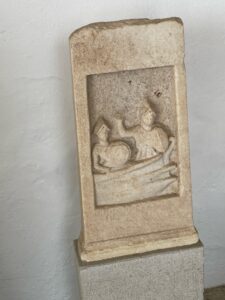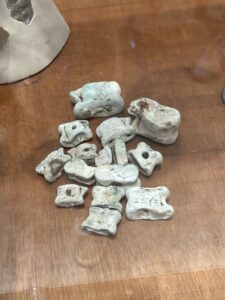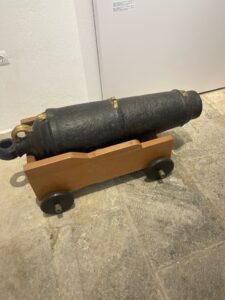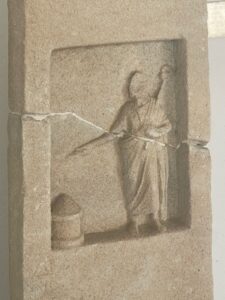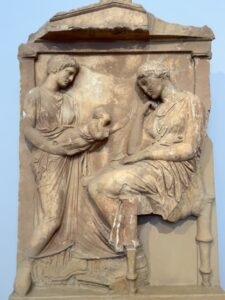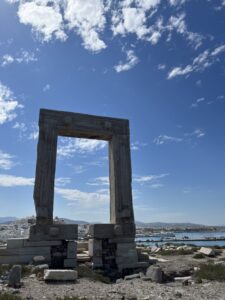Photos from “The Art, Archaeology, and Culture of Ancient Greece”
Check out these photos from the study abroad program “The Art, Archaeology, and Culture of Ancient Greece” – May 2022!
In the middle of our first group dinner at Εύχαρις where we had some amazing Greek food. (May 9) Photo and caption by student Shannon Cummings.

The stunning view of the Acropolis from the roof of our hotel on the first night! (May 9) Photo and caption by student Shannon Cummings.
Group selfie in front of the Temple of Hephaestus, the best preserved ancient Greek temple in the Agora. (May 10) Photo and caption by student Shannon Cummings.
Group photo featuring our awesome tour guide Kostas and Dr Warren in front of the Propylaea before at the Acropolis! (May 10) Photo and caption by student Shannon Cummings.
Group photo in front of the Parthenon. There’s no way to put into words how breathtaking this temple, you have to visit and experience it yourself!! Photo and caption by student Shannon Cummings.
We visited the Cycladic art museum today in Athens. This museum features artifacts that were found in some of the various islands around Greece. This specific picture is showing a female idol which is especially common from these islands. Photo and caption by student Willa Kate Baker.
This picture shows the beautiful scenery we had at lunch today! We had some fantastic Greek food and an orange pie for dessert that was delicious. Photo and caption by student Willa Kate Baker.
This afternoon we went to visit the temple of Poseidon located at the Sounion cape. This is a picture I took on the bus ride to the site. Photo and caption by student Willa Kate Baker.
This is the temple and a group picture of us in front of the temple. It was breathtaking and so much better because I got to experience it with such an amazing group of people. Photo and caption by student Willa Kate Baker.
View of the sea from the temple. Now I understand why it is called the temple of Poseidon! Photo and caption by student Willa Kate Baker.
First group dinner in Naxos enjoying a local restaurant! Photo and caption by student Rebekah Lassiter.
Walking the streets of Naxos at sunset. Photo and caption by student Rebekah Lassiter.
Temple of Apollo. Photo and caption by student Rebekah Lassiter.
The beautiful view of Naxos, from the hilltop of Apollo’s Temple. Photo and caption by student Rebekah Lassiter.
A local Greek Orthodox Church. Photo and caption by student Rebekah Lassiter.
Part of our Renaissance Naxos tour. Photo and caption by student Rebekah Lassiter.
Second group dinner. Photo and caption by student Rebekah Lassiter.
Temple of Apollo Door Frame, The Portara — Naxos, Greece. Photo and caption by student Sid Subramanian.
Group Dinner at Apostolis, nestled in the Old Town Quarter of Naxos! Photo and caption by student Sid Subramanian.
The Temple of Demeter — ruins near the inland village of Sangri, Naxos from 530 BC. Next to the ruins now lies a church! Photo and caption by student Sid Subramanian.
An inland garden treasure — a fallen marble statue from the cult of Dionysus, the Greek god of wine! Photo and caption by student Sid Subramanian.
A cozy dining square in a village up in the mountains of Naxos. Photo and caption by student Sid Subramanian.
Photos and captions from May 15th-17th by student Claire Latimore:
Our next stop was Mykonos! We saw the windmills and the temple of St. Nikolas, the patron saint of sailors. The second day we toured Delos. Delos was the mythical birth place of Apollo and was an important center of trade. It was also a prosperous island during Roman times. The last picture shows the mosaics rich Romans would have on the floor of their homes.
Photos and captions from May 19th by student Sophie Kotlove:
First we visited the largest tomb in Mycenae. It is not known exactly who was buried there, but it is referred to as the tomb of Agamemnon, as he may have been buried there if he was a real historical figure. Photo and caption by student Sophie Kotlove.
The lion head gate on the way up to the acropolis of Mycenae. It was a windy walk but a worthwhile one! Photo and caption by student Sophie Kotlove.
A statue of Hygeia in the museum at Epidaurus with a snake twisting around her, from around 160 CE. Photo and caption by student Sophie Kotlove.
The stadium of Epidaurus, where games and contests would be held. The earliest record of games held here was in the 5th century BCE. Photo and caption by student Sophie Kotlove.
A group photo in the Ancient Theater at Epidaurus, the theater with the best acoustics in the world. We were treated to a lovely song sung by our tour guide, as well as by another student on the trip, Katharine Collie, and could hear them loud and clear from the back row! Photo and caption by student Sophie Kotlove.
Photos and captions from May 20th by student Hope Nitsche:
Group picture in front of the Temple of Apollo in Ancient Corinth. Photo and caption by student Hope Nitsche.
A statue of Theodoros Kolokotronis, one of the leaders of the Greek Revolution against the Ottoman Turks. Photo and caption by student Hope Nitsche.
A street in the city of Nafplion, the first capital of the country of Greece after they gained independence from the Ottoman Turks. Photo and caption by student Hope Nitsche.
A Sphinx in the museum of Ancient Corinth. Photo and caption by student Hope Nitsche.
A Mosaic from the Roman Period in the Museum of Ancient Corinth. Photo and caption by student Hope Nitsche.
One of the Phrygian Captives, who were enslaved by the Romans and were made into columns to show Roman power. Seen in the Museum of Ancient Corinth. Photo and caption by student Hope Nitsche.
Statue of Augustus, the first emperor of Rome in the Museum of Ancient Corinth. Photo and caption by student Hope Nitsche.
Photos and captions from May 21st from student Katharine Collie:
The first photo of the group was taken at the archeological site of Delphi. Photo and caption by student Katharine Collie.
The second photo is the sphinx that guarded the Athenian Treasury and was given as a votive by the people of Naxos. Photo and caption by student Katharine Collie.
The third photo is us in front of the Temple of Apollo at the archeological site of Delphi. Photo and caption by student Katharine Collie.
The fourth picture is the fabled rock that Zeus threw to find the middle of the Earth, which landed in Delphi. Photo and caption by student Katharine Collie.
The fifth photo is of a bronze charioteer discovered in Delphi, which avoided the ravaging of robbers as it was buried in an earthquake. It depicts a teenage boy as a charioteer and was part of a bigger piece of a bronze sculpture including a chariot, horses, and a boy attending the horses. Photo and caption by student Katharine Collie.
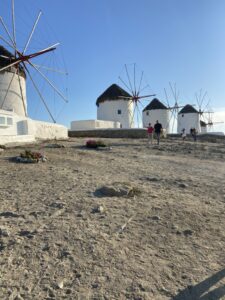
May 15th: The famous windmills of Mykonos! Being there for sunset was an amazing view and it was really nice by the water and the rest of the old port area. Photo and caption by student Sophie Kotlove.
May 22nd: A marble horse statue in the courtyard area of the National Archaeological Museum made in around 100 BCE. It was found underwater due to a shipwreck, which accounts for its interesting looking appearance. Photo and caption by student Sophie Kotlove.
One of my favorite places that we visited was the theatre at Epidaurus. It is the largest and most intact theatre from ancient times and it has acoustics so incredible that one’s voice can be heard from the center of the stage to the back row. I sang part of Wolfgang Amadeus Mozart’s “Ridente la calma” there and it was really intimidating, but amazing to hear my voice amplified throughout the theatre without the use of microphones and speakers. Photo and caption by student Katharine Collie.
These are Cycladic carved figures we saw at the National Archaeological Museum. One of them is shown to play the double pipe while the other figure sits in a chair and plays the harp. Photo and caption by student Katharine Collie.
National Archeological Museum — Funeral Kouros. This artifact is incredibly interesting as it is elegantly carved in the form of a gravestone to likely have honored the contributions and career of an athlete. The carvings are realistic in the marble and indicative of the muscular masculine ideal and perceptions of wrestling and fighting being primary athletic pursuits. Photo and caption by student Sid Subramanian.
Temple of Apollo Door frame — Naxos. There has been no time where I felt more at peace, introspecting on my life, on top of the hill with the temple of Apollo door frame looking out into the distant night with the cool breeze seemingly swaying me from side to side. There was not a sound but the beauty of the waves crashing against the rocky shore, and after the overwhelming semester that I had, Naxos definitely filled in that missing sense of tranquility in my life. Photo and caption by student Sid Subramanian.
National Archaeological Museum Post: I found these octopi pieces most interesting as it’s a common meal and jewelry item in Greece. Photo and caption by student Rebekah Lassiter.
Retrospective post: My favorite memory from the trip was visiting the Alice in Wonderland street in Athens. While not directly related to Ancient Greek times, it portrayed the somewhat unworldly experience of seeing and experiencing such ancient artifacts. Photo and caption by student Rebekah Lassiter.
One of my favorite memories from the trip was when we visited the Island of Delos, the birthplace of the god Apollo. We saw the ruins of the ancient city but among these ruins. so many flowers were growing everywhere. Not only did we see a city that was important to the Athenians and many other Greeks, but we also saw life reemerge from the city once again, with the blooms of the flowers. I will remember the beauty of Delos forever. It was one of my favorite sites to visit. Photo and caption by student Hope Nitsche.
A marble statue of a young woman, a kore, in the National Archeological Museum in Athens. This statue is one of the few kore statues that still has its hands because it was carved out of one block of marble. Most of the other kore statues have outstretched hands, which means that their hands were made out of different marble blocks, and then attached to the main statue. If you look closely, you can see the colors and patterns that adorned her dress and all of the marble statues of Ancient Greece. Photo and caption by student Hope Nitsche.

This picture is of a statue that is found in the National Archeological Museum in Athens. This statue is made out of marble, but has broken down over time because it was found in the ocean where it was rescued from a shipwreck. The character that is being depicted in this statue is Herakles and is said to date back to the 1st century BC. One of the reasons why I found this statue so interesting is because so much of it remained preserved even though it was found at the bottom of the ocean. I was also very surprised that the statue remained intact even though it survived a shipwreck, an event that I would think would cause it to be destroyed or at least broken into many pieces. Photo and caption by student Willa Kate Baker.
This picture was taken in front of the temple of Demeter and Persephone. This is one of my favorite pictures from the trip because it represents two of my favorite elements of the trip. The first being the archeological sites that we got to visit. It is one thing to learn about the ancient Greeks through a textbook or by walking through a museum but actually seeing the sites in person is a breathtaking experience that I really enjoyed and appreciated. A second element that I loved about this trip was the friendships that I made. Everyone that was on the program had a similar appreciation for the Ancient Greek culture so we immediately bonded because of this, but it was also in traveling together that we really became close friends. Photo and caption by Willa Kate Baker.
Photos with captions from May 18th by student Gavin Mora:
Pictures from our visit to the Archaeological Museum in Mykonos. Established in 1902 the museum displays artifacts discovered in Mykonos and neighboring islands dating from the 5th century bc.
1) Marble statue of Hercules – a young Hercules with fur of the slain nemean lion
2) Greek Trireme – naval boat the Greeks used in warfare
3) Knuckles – bones from sheep used by ancient children as toys
4) Painting of ship with religious deity in sky – depicts the expansion of Greek Orthodox Church into Eastern Europe
5) Small Figurine of Greek theatre actor – typical of the period
6) Cannon from Greek Civil War
7) Plaque of ancient burial of poor citizen
This is a grave stele carved in the first quarter of 400 BC. It depicts a young mother looking sadly at her baby which is held by another woman. The baby’s face is not sorrowful like the two women because he does not truly understand that his mother is dead. Photo and caption by student Claire Latimore.
This is the gate of Apollo in Naxos. This was supposed to be the site of an entire temple to Apollo, but it was never completed. However, the gate was still a beautiful monument and quite grand despite being incomplete. Behind the gate you can also see some of Naxos’s pictuesque chora as well as the sea. Photo and caption by student Claire Latimore.

